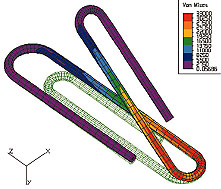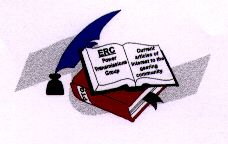

A new type of software provides a virtual laboratory where you can test virtual prototypes to optimize designs without a stress analysis.
MICHAEL BUSSLER

| Standard linear FEA is incapable of showing permanent deformations that occur in the simplest products such as paper clips, and metal-bending manufacturing tasks. But event-simulation software lets users "pull" on a model to see the permanent deformation and residual stresses that result from the bending. Models are set up the same way as they would in a linear analysis package. |
In the old days, most load-bearing parts were not stress analyzed rigorously. The available stress equations were generally either too complicated or too approximate to be useful in workaday industry. A design engineer typically might use equations from textbooks to do a proverbial back-of-an-envelope stress analysis, but the results were so approximate and laden with assumptions that they provided only a hint of what would happen in service.
For this reason, critical parts were typically stress-tested as prototypes in a laboratory, or they were run through accelerated service tests in the field. In either case, the analysis was typically performed by or managed from the desk of a design engineer. Even today, in many quarters of industry - perhaps even in the majority of firms - this is the way structural design and engineering optimization are handled.
| The next step in the development of simulation software lets it show how objects perform in use. For example, to see how a thin wall tubing might behave - not just spot high stresses - engineers can use event simulation capabilities to show exactly what happens when someone steps on the 3D beam. The significance of this analysis is that it predicts local buckling, a phenomena that bends the tube without initially exceeding the material yield stress. A similar simulation previously would have taken complex and difficult-to-learn nonlinear analysis software. |
The advent of finite-element analysis brought a marked transformation, at least in the more sophisticated sectors of engineering. When first introduced, the entire process of FEA, from modeling to interpretation of results, was a complex science requiring implementation by experts, preferably with post-graduate training. Even designing an FEA model was highly complicated, to say nothing about solving FEA equations and making sense of their results. This complexity, in turn, also brought a philosophical change. It took analysis away from designers and placed it in the hands of gurus whose basic tools were mainframe computers.
The trend started to reverse when software houses began developing FEA programs for personal computers. This allowed many types of advanced structural analysis to begin migrating back to the desks of design engineers.
Still, FEA is not as simple to understand nor as intuitive to apply as the testing of prototypes. With testing, when something works, you can tell that it does. And if it doesn't work, that too will be obvious from your bent or fractured specimens. In all, engineering would be faster, easier, and more accurate if a computer could run tests on virtual prototypes with results as obvious as those from real prototypes in an actual test lab. If this were possible, virtual prototypes could be optimized by a computerized trial-and-error process rather than by real tests on physical prototypes.
A new type of software allows precisely this type of computer simulation. It does not focus, as current FEA does, on modeling a part and calculating its response to specified forces, usually static. Instead, it models what happens to the part in service, with particular emphasis on motion and dynamic phenomena in the form of acceleration, deceleration, and impact.
| Modeling motion in mechanisms usually requires a separate software package and a manual transfer of data from one to the other. Event simulation software combines dynamic or motion analysis with stress analysis so that the software combination shows the effect of flexing in the pivoting beam as the mechanism operates. |
For example, suppose an appliance manufacturer wants to ensure that a coffee pot won't break if it is accidentally knocked off of a kitchen counter. The manufacturer can, of course, make samples and knock them off a counter to see what happens to them. Or with a more sophisticated approach, the manufacturer could do an FEA analysis, where the designer would measure or make assumptions about the forces caused by the drop, run the analysis to calculate stresses, then compare results with property data and make judgments about whether or not the pot will break. Interestingly, although this procedure is considered state of the art today, it is still fundamentally the same as 1930s-era engineering done with handbooks and slide rules. The only difference is that a computer makes the process more accurate if not faster.
With a new concept, which we call virtual engineering, the designer models the pot and defines that it is to drop from a specified height to a surface of specified hardness. Then on a computer screen, the software shows the trajectory and bounce of the pot - or how it shatters - as well providing a map of stress contours as they exist at any time during the impact or bounce. (There are cases where dropped objects experience their highest stresses not at their moment of impact but rather after they have bounced off a surface.)
If the pot breaks or dents, that too is shown. Eliminated are the assumptions about loads and the need to compare calculated stresses to property data. In short, the design engineer has run a virtual make-and-break prototype test on the computer.
At the risk of getting overly philosophical about the new process, it is interesting to note that it more directly addresses the true objectives of engineering. Fundamentally, the objective of engineering has never been to make a better product. The objective is to reduce trial and error while avoiding failure. Virtual engineering, by making it easier to explore virtual alternatives, drastically reduces trial and error with real components.
| Linear FEA produced the stress field in the bracket to the left. With it, an engineer might be prompted to overdesign the part. Event simulation software, on the other hand, presents a more accurate distribution of stress thereby reducing the potential for overdesign and enabling the engineer to see the actual safety factor. |
| After modeling the hammer and floor, and indicating the direction of gravity, users can run the simulation of a falling object, such as a hammer without assigning contact elements. Traditional nonlinear FEA would call for a more complex setup. |
| Users need define only the motion limits and constrain the rear tabs to model snap-through phenomena. Event simulation software shows a resistance to motion and the velocity jump from the sudden snap-through. |  |
This idea began to take shape four years ago when we realized that improving the traditional linear static FEA process itself has inherent limitations due to theoretical constraints. Therefore, we decided to try to improve the process of engineering. We concluded that FEA needs to be expanded to include all components of the traditional engineering paradigm. By providing software that enables the user to treat the computer as a "virtual laboratory," we elevate the discipline of traditional engineering to the plane of virtual engineering. Moreover, this process could represent the initial steps of how engineering will be done in the future. In all, it introduces a way to do analysis that is parallel to the highly intuitive and direct approaches used in a laboratory to test prototypes.
| Intuition tells people that placing enough weight on a simply supported plate will bend it and eventually pull one edge off a support. Event simulation software has a similar "intuition." Linear FEA, however, does not predict the fall-through. |
The software on which the process is based is not cutting edge but instead is evolutionary. Engineers can use this approach today. The development began with improvements to our solvers as a result of work we funded at Carnegie-Mellon University. A key concept of this work is that time is factored into the solution. It is necessary to factor in time because most product failures typically involve motion. For example, most automotive recalls have something to do with some aspect of movement.
Motion produces velocity, which is the derivative of position with respect to time, and the derivative of velocity with respect to time is acceleration. The product of acceleration and mass is force, and force is what makes parts fail. That is why time is so essential to the analysis. Conventional FEA packages, nonlinear as well as linear, cannot deal with loads defined by motion.
In virtual engineering, the inclusion of time and motion allows us to do what we call event simulation. The process is performed by proprietary software combining kinematic nonlinear simulation with nonlinear static and dynamic FEA. This capability allows the software to combine the effects of motion, impact, stress, the dynamics of flexible bodies, and impact analysis. It also factors in material properties.
An important feature of event simulation is the way it combines static and dynamic analysis, which are kept separate in conventional FEA. To do virtual engineering, you build a model the same way you would for a linear problem. The process reduces the amount of assumptions necessary, which is a great benefit because assumptions are often greatly in error. And safety factors can be established taking into account the full nonlinearities of the system.
As we have mentioned, virtual engineering shows how the part moves, bends, or deforms right on the computer screen. In conventional FEA, if deformations are large enough to see, they may represent errors from excursions beyond the l imits of linear theory. This ability of virtual engineering to provide vivid depiction is especially valuable because corporate decisions are increasingly being made by people who don't understand engineering. So it helps to be able to show them what happens to the product in service.
Where does all this leave traditional linear static stress analysis? In virtual engineering, stress analysis happens to be a by-product of event simulation but not necessarily a crucial end result. In addition, the designer doesn't have to look up property data to interpret the results. Instead, this information is part of the original model. The design engineer can know less about analysis, less about materials, and less about physics, but still get the job done. This situation is not substantially different from engineering in the 1930s. Today, you simply test your prototypes in a laboratory that is virtual rather than real.
 | Squashing a rubber ball into a pancake exemplifies the possibilities for more easily studying the behavior of elastomers with event simulation software. Seal studies, for example, were once the domain of complex nonlinear FEA. The more recent package now lets users see how an O-ring might fill its intended groove. |
 To enter the article library.
To enter the article library.
Content Machine Design, Penton Publishing,1997
![]()
Vision |
Eng.-Info. |
Presentations |
Organization |
Whats New
Areas of Core Competencies |
Case Studies |
FAQs and Tips
Feedback |
Intranet |
Universities |
Training & Career Development |
Databases
Engineering Technical Report Area
Questions? E-mail to the Webmaster at the Engineering Resource Center![]()